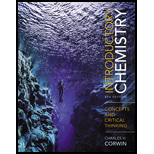
Concept explainers
(a)
Interpretation:
The given metric-metric conversion is to be stated.
Concept introduction:
The metric system unit is the unit system which is accepted as the standard system of unit internationally. The nonmetric units are the common unit system which is not standard for the parameter to be calculated. The unit factors are calculated by taking the ratio of two equivalent measurement systems and these are used in unit conversions.
Answer to Problem 16E
The given metric-metric conversion of
Explanation of Solution
The relation between meter and megameter is given below as,
The conversion of
The given metric-metric conversion of
(b)
Interpretation:
The given metric-metric conversion is to be stated.
Concept introduction:
The metric system unit is the unit system which is accepted as the standard system of unit internationally. The nonmetric units are the common unit system which is not standard for the parameter to be calculated. The unit factors are calculated by taking the ratio of two equivalent measurement systems and these are used in unit conversions.
Answer to Problem 16E
The given metric-metric conversion of
Explanation of Solution
The relation between gram and milligram is given below as,
The conversion of
The given metric-metric conversion of
(c)
Interpretation:
The given metric-metric conversion is to be stated.
Concept introduction:
The metric system unit is the unit system which is accepted as the standard system of unit internationally. The nonmetric units are the common unit system which is not standard for the parameter to be calculated. The unit factors are calculated by taking the ratio of two equivalent measurement systems and these are used in unit conversions.
Answer to Problem 16E
The given metric-metric conversion of
Explanation of Solution
The relation between liter and milliliter is given below as,
The conversion of
The given metric-metric conversion of
(d)
Interpretation:
The given metric-metric conversion is to be stated.
Concept introduction:
The metric system unit is the unit system which is accepted as the standard system of unit internationally. The nonmetric units are the common unit system which is not standard for the parameter to be calculated. The unit factors are calculated by taking the ratio of two equivalent measurement systems and these are used in unit conversions.
Answer to Problem 16E
The given metric-metric conversion of
Explanation of Solution
The relation between second and decisecond is given below as,
The conversion of
The given metric-metric conversion of
Want to see more full solutions like this?
Chapter 2 Solutions
Introductory Chemistry: Concepts and Critical Thinking Plus MasteringChemistry with eText -- Access Card Package
- A bicycle accelerates from 5 miles per hour to 15 miles per hour. Does its energy increase or decrease? Is the change in potential energy or kinetic energy?arrow_forwardComplete the following table by filling in the blanks in each row with the name of the metric unit, the property being measured (mass, length, volume), and/or the abbreviation for the metric unit. The first row has been completed as an example.arrow_forwardThe diagram in (a) shows a compound made up of atoms of two elements (represented by the green and red spheres) in the liquid state.Which of the diagrams in (b) to (d) represent a physical change, and which diagrams represent a chemical change?arrow_forward
- If a red and green solution are mixed and an orange mixture esults, is this evidence of a physical change or chemical change?arrow_forwardA car travels 28 mi per gallon of gasoline. What is the mileagein kilometers per liter?arrow_forwardheight of 100ml graudated cylinder in cm is 24.0 cm, what is it in m, inches, km, feet showing workarrow_forward
- Which of the following is the greatest thickness: 1 mm, 0.1 cm, or 0.001 m?arrow_forwardThe shotput used by female track and field athletes has a mass of 4.0kg. What would be the weight of such a shotput in pounds?arrow_forwardWhich of the following particulate illustrations represent pure substances and which represent mixtures?arrow_forward
 Introduction to General, Organic and BiochemistryChemistryISBN:9781285869759Author:Frederick A. Bettelheim, William H. Brown, Mary K. Campbell, Shawn O. Farrell, Omar TorresPublisher:Cengage Learning
Introduction to General, Organic and BiochemistryChemistryISBN:9781285869759Author:Frederick A. Bettelheim, William H. Brown, Mary K. Campbell, Shawn O. Farrell, Omar TorresPublisher:Cengage Learning Introductory Chemistry: A FoundationChemistryISBN:9781337399425Author:Steven S. Zumdahl, Donald J. DeCostePublisher:Cengage Learning
Introductory Chemistry: A FoundationChemistryISBN:9781337399425Author:Steven S. Zumdahl, Donald J. DeCostePublisher:Cengage Learning Introductory Chemistry: An Active Learning Approa...ChemistryISBN:9781305079250Author:Mark S. Cracolice, Ed PetersPublisher:Cengage Learning
Introductory Chemistry: An Active Learning Approa...ChemistryISBN:9781305079250Author:Mark S. Cracolice, Ed PetersPublisher:Cengage Learning General, Organic, and Biological ChemistryChemistryISBN:9781285853918Author:H. Stephen StokerPublisher:Cengage LearningChemistry: Matter and ChangeChemistryISBN:9780078746376Author:Dinah Zike, Laurel Dingrando, Nicholas Hainen, Cheryl WistromPublisher:Glencoe/McGraw-Hill School Pub Co
General, Organic, and Biological ChemistryChemistryISBN:9781285853918Author:H. Stephen StokerPublisher:Cengage LearningChemistry: Matter and ChangeChemistryISBN:9780078746376Author:Dinah Zike, Laurel Dingrando, Nicholas Hainen, Cheryl WistromPublisher:Glencoe/McGraw-Hill School Pub Co





